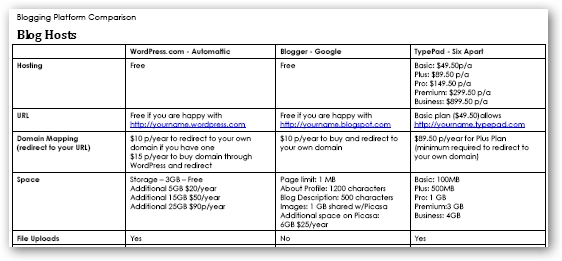I often get questions about creating, maintaining, and optimizing an online presence from small businesses and non profits; how to get into search engine results, how to redesign an old site, what tools are available that are useful, inexpensive or free.
If you know of any tool or resource I have not listed, that is particularly good for small businesses, please take a moment and leave it in the comments below.
Before you Launch your Small Business Website
Before you Launch that Local Small Business Website
Read Rae’s tips on what you need to think about before you launch your small business website - particularly good if you have yet to begin your online presence.
Your Domain Name
If you want to create a professional and credible site, one that enhances your product, service, or business, it is imperative you choose your domain name with care. Problogger Darren Rowse explains how the right domain name can make or break your business.
10 Tools for Researching Domain Names
Not only is it important to find the right name, it’s imperative to make sure that the name you decide on doesn’t have any bad history associated with it. Steven explains it best and offers 10 tools for you to use in your research.
Blog Dammit!
Duct Tape Marketing author, John Jantsch, provides number five in a five part series, Blog Dammit! and explains why you must start and grow a blog in 2008 if you haven’t already.
WordPress: Not Just for Bloggers Anymore
Did you know that WordPress lets you build an entire website; one that is optimized for search, easy to setup and maintain, and requires very little technical nouse? If you don’t, read this article by Barry Ochsner
Creating and Maintaining an Audience
How to Get Repeat Visitors for Your Website
There are two types of visitors to a site: new visitors and repeat visitors. In this article, Maki provides insight into how to create an online place that people will want to return to.
Give Your Readers Room to Participate in Your Blog
If you are having a hard time getting visitors to leave comments, read this article by Problogger Darren Rowse that explains how you can gently encourage and engage your readers, and build a reputable online presence.
10 Free Ways to Get Blog Exposure, New Readers and Success
There is much you can do if you want to spend money on getting exposure on the Web, but what can you do to increase exposure without having to pay one cent?
Analyzing Your Site
Analytics On The Cheap: Six Free Stats Packages for the Startup or Small Business Owner
If you’re not analyzing your website, you should be. Tamar Weinberg describes six free statistics packages and explains how they can help your business.
Competitor Analysis to Build Traffic and Links
Having an analytics package isn’t enough. You need to understand how they work so you can perform competitor analysis and use the results effectively to grow your own site.
Website Grader
Website Grader measures your site’s marketing effectiveness. It gives you a score that incorporates information from Alexa, PageRank, Technorati, Del.icio.us, and offers information about the health of your site (how many links in, from where, etc). Good for an overview, but will never replace a professional SEO audit. Read Michael Gray’s post
Why Website Grader is a Bad Idea for more information.
Check your Google PageRank
Type in your URL and your Google PageRank will be displayed.
Google Webmaster Tools
See how Google crawls your site and any problems it’s having; you can also see how your site is performing here.
DNScoop
DNScoop attempts to estimate the value of an established website or a domain name, by using factors such as; links, popularity, age, pagerank and traffic of the domain.
Business Blogging
Business Blogging 101
Darren Rowse gets you thinking about how businesses should use blogs, and gives you the basics in plain English if you want to start blogging.
Choosing a blog platform
There are many blogging platforms around, some requiring technical know how, others not. Read this post if you are not sure which platform suits your needs best.
WordPress.com
For an easy to use, non-techie approach to blogging, WordPress will give you more than other platforms. Ad-Free, customizable, and optimized for search, Google loves WordPress, so will you. If you are tech inclined, you can run
WordPress software (free) on your own site. See also,
WordPress.com vs. WordPress.org for more information about the differences.
How to install WordPress software
Ten video tutorials from Stefan Mischook on how to install and configure WordPress if you want to give it a go yourself.
Ninja Blog Setup
If you decide to go with WordPress software and host it yourself, but don’t want the headache of setting it up yourself, these guys will set up a blog for you, for free. They make their money by providing hosting partners.
Small Business Blogging: What to Blog About
If you’re not quite sure what to write about, read this post by Dan Bricklin that offers practical advice for small businesses.
Legal Guide for Bloggers
The Electronic Frontier Foundation offers a basic guide to laws surrounding bloggers.
De Clutter your Blog
If your blog looks cluttered but you aren’t sure which components you should remove, read this. This is particularly interesting for those who cannot work out the ‘musts’ in a sidebar.
10 WordPress Plugins that Encourage Visitors to Return
If you want your blog to be user friendly, there is no nicer way than to offer visitors options that are useful and helpful.
10 Things CEOs should know about Web Design
Anita Campbell points out what works and what to steer clear of when it comes to Web design.
Design decisions that annoy readers
Things to think about and not do when designing your site.
9 Ways to Gauge Your Visitors’ Experience
Vandelay Design helps you understand the opinion of your visitors, and explains why you need to take the time.
Signs it’s Time to Redesign your Website
Erin Ferree points out seven ‘tells’ that will let you know it’s time to redesign.
Does your Web Site Suck?
Two checklists from Vincent Flanders, author of Web Sites that Suck to help you determine whether you need to overhaul your site. Fill them in, learn from them, and
then use this page to help you fix things.
How to Redesign a Website
You’ve made the decision to overhaul your site, now what? From .net magazine, the things you might want to consider.
How to evolve your irrelevant corporate website
Jeremiah Owyang, Senior Analyst at Forrester Research explains why your website may be irrelevant, and gives tips on how to rebuild to stay relevant.
Best Premium WordPress Themes For a Non-Blog Look
If you don’t like the blog look, but want the advantages that a blog brings, take a look at Donna’s post.
Cream of the Crop: Six Cutting-Edge, Minimalist WordPress Themes
According to Skellie, these six themes are at the forefront of modern, minimalist, typographically interesting WordPress theme design. She also tells you how to tweak them for maximum impact.
Content for Your Small Business Website
The Seven Deadly Sins of Website Copy
Michel Fortin shows how simple copy changes to your site can transform an average site to a great site.
The Power of the “About Us” page
Do you have an “About” page? Was it just thrown together, or did you spend time putting it together for maximum impact? Bryan Eisenberg gives expamles of the most common mistakes.
Building More Effective “Contact Us” Pages
When putting together a site, not many people think about their contact information. It’s time you did and Bryan Eisenberg shows you how.
Forms that Work: From the book Web Design for ROI (Sample chapter PDF)
If you have forms on your site, read this and make sure you don’t annoy your visitors by making your forms too tricky
Page Not Found: Error 404
What makes up a good error page? Have you even thought about it? If you haven’t, it’s time you did. WebMama shows you what to think about.
The “Coming Soon” page
While not everyone agrees you should have a coming soon page, if you decide you need one, take a look at this first.
A Complete Guide to Finding and Using Incredible Flickr Images for Free
Skellie shows you how to make your site more interesting by incorporating great imagery. It doesn’t need to cost much; oftentimes it will cost you nothing more than time.
Search Engine Optimization for Small Business
SEO Jargon Buster
A complete glossary of essential SEO jargon for beginners.
13 Ways to promote your local business for free
Small businesses take note. Michael Gray gives you quick and easy tips to get noticed in search results, that can bring more traffic to your site.
10 Tips to Improve Your Search Engine Ranking
Mike Busson explains that search engine optimization is not rocket science; you just need to be aware of the basics.
7 Steps to Get Your New Site Indexed in 24 Hours
There are ways to speed up getting noticed by the search engines; you just need to know what they are. Michael Jensen explains.
7 Simple Ways to use Universal Search to Appear on Top of Google
Tad Chef walks you through the various components that make up Universal Search and how to use them to increase your chances of being included in Google’s search results.
What is the First SEO Question?
What is the Second SEO Question?
The first two questions you should ask yourself before you embark on an SEO program, and a third on the way from WebMama.
Introduction to Keyword Sniping
How to choose keywords, and how to use keywords; one of the most important articles you can read from Courtney Tuttle.
All about Permalinks
Mark Blair explains permalinks, and why it is important to get them right if you want search engines to like your site.
All about Title Tags
Title tags make up the text that appears in the top left hand corner of your browser when you visit a Web site. Did you know that you can choose to put your own words there? Jill Whalen offers the ultimate in title tag explanations.
All About Description Tags
Rand Fishkin shows you how to make the most of your meta description tags. If you don’t know what they are, you will by the time you read this.
Optimize Video for Search Engines
Video is getting bigger on the Web every day. If you decide to use video, Jody Nimetz gives you tips to optimize them for search engines.
Optimize your Website for Google Image search
Maki explains how to optimize your images, make your site more visually attractive, and attract search engine traffic at the same time. If you’re not doing anything but uploading pictures, it’s time to understand how it all works.
Linking Strategy for Small Business
The Ultimate guide to building the perfect link
The biggest problems small businesses face is getting links to their site. Matt McGee walks you through types of links, how to approach them and what not to do.
102 Ways to get backlinks
Written in the order they need to be done, Courtney Tuttle walks you through how to get links to your site the right way.
Link to Yourself Using Anchor Text
Anchor text is extremely important if you want search engines to notice you under specific key words, Darren explains why and how to do it.
20 Ways to Get Legit Links Without Getting Penalized by Google
If you don’t want to annoy Google, but want people linking to your site, try Tad’s recommendations – they work.
Link Buying Guide: Directories, Ads and Reviews
If you want to buy links, buy links that don’t jeopardize your online presence. Loren Baker lists his favorites.
PR and Marketing
Blogging’s a Low-Cost, High Return Marketing Tool
From the New York Times, a recent (Dec 07) article explains how, for some small businesses, blogging is the way to go if they want a great tool to raise the company profile and build their brand.
Ways to Market your Business Online
You can’t expect to compete as a small business today without choosing from a growing arsenal of online marketing tools. Here are four ways to get your business noticed on the Internet from CNN Money.
I am Clueless About Your Product: Sell it to Me Correctly
Tamar Weinberg points out the importance of using everyday words on your site if you have a product to sell. Use the KISS method, easy but often forgotten.
The Etiquette of E-mail
Good business means communication, and although e-mail is used a lot, it’s not always used correctly. Gina Trapini shows you how to do e-mail right.
Features Vs. Benefits: The Showdown
Do you know the difference between the features and the benefits of your product or service? If you don’t, you should. It makes marketing your small business oh so much easier. Naomi explains.
Lowdown on press release optimization
Lee Odden shows you how to write a great press release, and offers a list of wire services you can use to distribute them.
How to Advertise your Website or Business: 8 Paid Advertising Models
Advertising is one of the fastest and easiest ways to bring traffic to your site—if you do it right. Read this if you want to understand the various types of advertising, and how to work out the best places to advertise.
How to Get News Coverage
A beginner’s guide to getting media coverage, particularly useful for those with small budgets.
Reputation Management and PR for Small Business
Online Reputation Management for Beginners
Andy Beal walks you through the importance of online reputation management. Did you know there’s a good chance that your name, your company, or your brand is out there somewhere on the Web, quite possibly put there by someone you may not know?
Search Engine Reputation Management Techniques
If you’ve ever come across your name (or your company name) on the Internet, in an unflattering light, try these techniques and turn the bad press around.
Want Your Business to be Featured on CNN? Send an I-Report
Share your tips in with CNN and you could be featured on television. Just fill in the form and you’re set.
Social Media for Small Business
Ten Reasons to Use Social Media
Tad explains the importance of using social media; why and how it can benefit your online business.
Strategies for Winning in a World Transformed by Social Technologies
Charlene Li, senior analyst at Forrester talks about what business objectives and results can be achieved with Web 2.0 technologies and how social technologies will transform your business in the future. Audio and Video available (approx 1 hour) at PARC (Palo Alto Research Centre).
The Importance of Social Media Marketing
Maki explains how social media marketing is a low cost way of promoting your site that will get you links, attention and lots of traffic.
Online Networking and the Professions That Use It
If you haven’t been networking online, it’s time you start. Muhammad Saleem points out networks for the medical profession, musicians, educators, photographers, and business folk.
What is StumbleUpon?
Garrett Camp, Founder of StumbleUpon talks about what StumbleUpon is, how it works, why it works, and what they have learned over the years. A presentation for PARC (Palo Alto Research Centre) Audio and Video available (approx 1 hour).
What is Facebook?
According to Sugarrae, this is the updated, unofficial and smartass guide to using Facebook. If you’ve always wanted to know more, here’s your chance to find out what it’s all about in a fun way.
Facebook Ads and Will They Work For You?
Facebook advertising isn’t for everyone, but advertising on Facebook may work for you. This article explains how.
Ways to use Twitter
17 ways you can use Twitter: A guide for beginners, Marketers, and Business Owners from Maki
The Big Juicy Twitter Guide
A seven part series on what Twitter is about from Caroline Middlebrook
Effective Marketing on LinkedIn
If you’re using Linkedin and are not quite sure why, Helen shows you how to effectively market yourself with this business networking tool.
Useful Tools for Small Businesses on the Web
Blidget
Create a blidget; a widget that sits on your website and pulls in the latest entries from your blog. Customizable and free
Browsershots
Browsershots lets you test how your site looks in different browsers; Firefox, Opera, IE, Safari, running on different operating systems; Linux, Windows, Mac.
Colour Lovers
If you are planning changes to your Web site, Colour Lovers helps you work out what color schemes work well together. It also gives you RGB and Hex reference numbers if you want to pass them on to your site developer.
Contribute
If you are paying a programmer for each tiny change to your website, it can get expensive, and quickly. Contribute allows you to easily update pages on your site using your browser; no technical knowledge required and can save you tons of money in programmer fees. From Adobe - $169 with free trial period available.
Decluttered
How to declutter your desk. Not so much a tool, but a how to on making your desk neater; always good for business – and cheap and easy to do.
Deyey
Design your business cards online for free; then save them on your own PC and print them up. A nice alternative to better design without the cost.
Favicon Generator
A favicon (favorite icon) is an icon that is displayed in the browser address bar before the site’s URL. If you don’t have one, but want one, upload an image and the favicon generator will create a favicon for you to use.
Fax Zero
If you’re in the US or Canada and don’t have a fax machine, go to this site, upload your document and send your fax for free.
Feedburner
Feedburner is a free media distribution service for blogs and RSS feeds. This means you can automate the process of sending your news to your audience via e-mail or RSS. It also allows you to track who is reading your content.
GIMP
Gimp is a free powerful, full-featured photo editing program, comparable to Photoshop. Available for Linux, Mac, and Windows.
Google Alerts
If you want to know what is being said about you or your company online, Google Alerts offers you an easy way to keep track. Type in the words you want monitored (your name, your business name, your competitor etc.) and let Google e-mail you each time that word appears in search results.
Goog 411
Instead of calling 411 for information call 1800 Goog 411 ( 1 800 4664 411) and get a street address or phone number for free.
Icon Buffet
You need an icon, but where to get it? Become a member and get free icons sent to you, or buy your own packs here. The philosophy is quite neat. They give away free icons every month, but not everyone gets the same ones. The idea is to swap them (sorta like swap cards) and use what you like.
Icon Factory
The Icon Factory offers great looking icons you can use for your site as long as it is not for commercial use (then you have to buy them). But, for non profits, this just might be the way to go.
International Time
Does your business deal with customers internationally? Make it easy for them to contact you by adding a link to local time on your contact page–customizable.
Jott
Jott is a free service that converts your voice into text and sends it to you via e-mail or text message; great if you need to record something but don’t have a pen handy. (US only.)
Media Convert
You upload one file format, and Media Convert will convert it to another file format. Works with most formats of documents, spreadsheets, presentations, video and audio.
Montastic
Montastic monitor your website and send you an e-mail if it goes down. This free service can check your site every ten minutes, and saves you the trouble of visiting your site as often.
Open Source Web Design
Over 2000 fre







